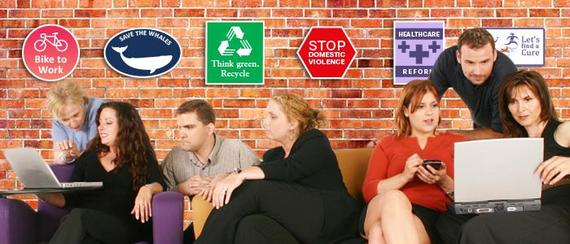Data scientist and MIT professor Alex Sandy Petland coined the term social physics to describe the way human social networks spread ideas and transform those ideas into action. As niche social networking services are becoming more prevalent and more focused, a window of opportunity is wide open for studying and understanding social physics.
While contemporary society and statistics are spawning unsettling theories about the repercussions of social networking, "Social Media is Making You Stupid" and depressed, a new trend and potentially a cultural shift is unfolding across the digital landscape--one that goes deeper than clicktivism and is far more illuminating than a high Klout score.
Among platforms that breed the most sharable and positively charged content that leads to synergistic, offline activity, a few common threads are present. These include curiosity, simplicity and purpose. Despite the onslaught of regurgitated listicles and selfies, more and more dedicated spaces for sparking meaningful dialogue, sharing thought-provoking content, and instigating action are emerging and finally proving to have staying power.
How do ideas spread?
The popular petition site Change.org illustrates a shining example of how an online platform can trigger the spreading of ideas that lead to action like wildfire. With 70 million users around the world and 30,000 new petitions and 3 million new members on the platform every month, Change.org promotes powerful stories that often help decision makers see issues differently, and in some cases, take notice of them for the first time.
"Whether it's the parents of Trayvon Martin who want justice for their son, a young woman who wants to be allowed to play middle school football, or a young gay man who wants to be allowed to be an Eagle Scout, so many of the petitions on Change.org represent the deeply personal experiences of real people who often wouldn't otherwise be able to make their voice heard," says Jake Brewer, Change.org's head of external affairs.
Brewer explains that online petitions are successful for two reasons: they're simple and they're effective.
"The stickiness [of the site] is in the simplicity," Brewer says. "Signing a petition on Change.org is a relatively easy thing to do that gives our users the opportunity to take action on something they care about or perhaps something they just learned about for the first time."
The next step after signing a petition is often to share that petition and invite others to join. From there, people often join organizations who use Change.org, allowing the organizations to gain new members and enabling people to continue taking more action through donations, further advocacy or volunteerism.
"Most important to the growth of Change.org has been the fact that people who start petitions are winning," shares Brewer. "When people who start or sign a petition are successful at creating the change they want, it makes them feel they can create even more change. And so they do!"
The new ideas-sharing site Ideapod, which is shaping up to be a futurists' social network, was created for the same purpose--to create positive change both for society and the individual. Currently in beta, Ideapod is an invitation-only site where users post ideas across a wide range of topics using urls, images and video with text limited to 1,000 characters.
"We think we're bringing a new method of organizing information to people," explains Ideapod Co-Founder Justin Brown. "Google has organized all of the world's information, and it's a huge online archive. Twitter disrupted Google's method by organizing information in real-time. By highlighting information at the level of ideas, Ideapod is actually organizing information that is related to the future, as an idea is a thought, concept, or suggestion designed to shift perspective moving forward."
No stranger to creating sharable content for the web, filmmaker and featured Ideapod member, Jason Silva, speaks often about his passion for the power of ideas and how it can move an audience.
"Usually if you evoke an emotional feeling in the viewer, you're good," says Silva. Erik Davis used the term 'lightning bolts of meaning" in the mind of the receiver. If people feel that from your content they will share that."
Brown says over the next six months, Ideapod will be progressively introducing features to help users collaborate more deeply on turning ideas into action. This way Ideapod will help turn discussion around ideas into a process for creating change.
What's the secret sauce for growing a social action network?
The act of using social media designed to make a difference is nothing new, but many sites in the social good space have had to pivot more than once to find a model that resonates with people.
When Change.org first launched in 2007 it was primarily a blogging network featuring posts about issues affecting communities all over the world. At one point, the development team put a petition on the site next to one of the blog posts to give readers the opportunity to take action directly alongside the story they were reading. In 2010, the site made a full shift to focusing on petitions.
Brewers says, "It was a natural shift as the most effective petitions are in themselves personal stories turned into an opportunity for action and change."
The tech company Causes has cultivated another social action-focused platform that has undergone major changes since its inception. Originally a Facebook application, Causes became its own independent network dedicated to helping people take action together in September of 2013. Raking in 5 million users per month, the site's key demographic is women in the U.S. ages 25-34.
To date, Causes has facilitated 50 million connections formed between users and other people, as well as users and organizations. Causes CEO, Matt Mahan, says that when people ask both Facebook friends and members of the Causes platform to lend support, the connections on Causes are twice as likely to take action than their regular Facebook friends.
"Our democracy is broken," shares Mahan. People don't participate nearly enough because they don't believe their voice matters. We're trying to fix democracy by asking people to act collectively. It's pretty natural for us that we would move to being our own network. We found people needed a dedicated space. "That's why we launched this dedicated network for purpose."
Whether it involves signing a petition, sharing an idea with 1,000 characters, or mobilizing team action, people are looking for content to inspire them and offer the possibility for real-world results. This is a kind of social physics worth analyzing.
This post was originally published on Cisco's Technology News Site.

